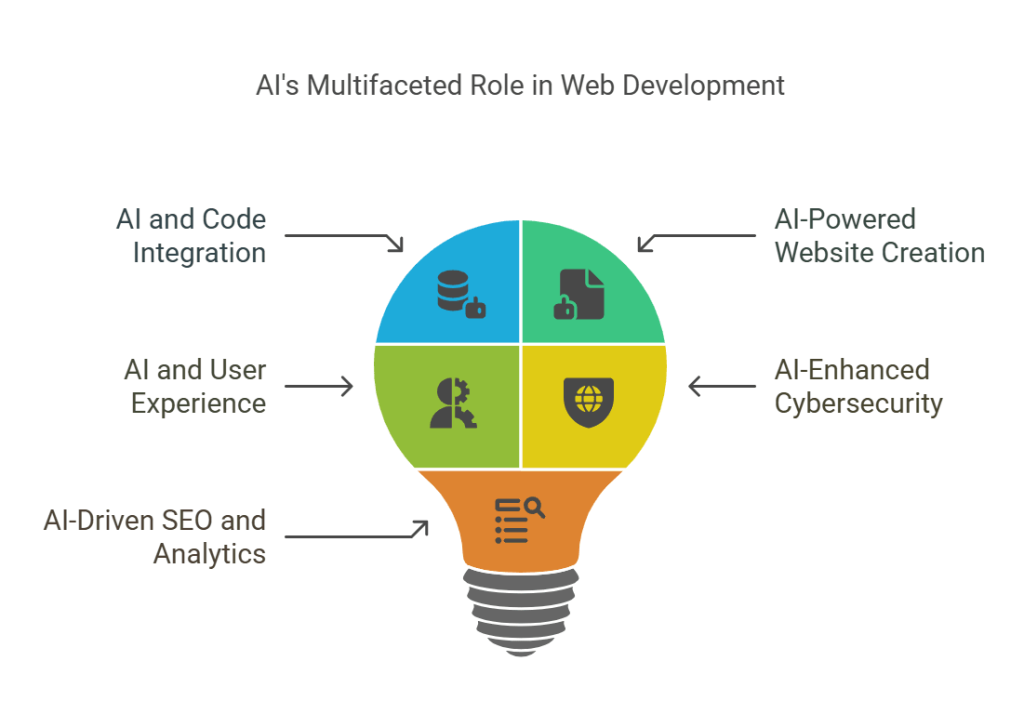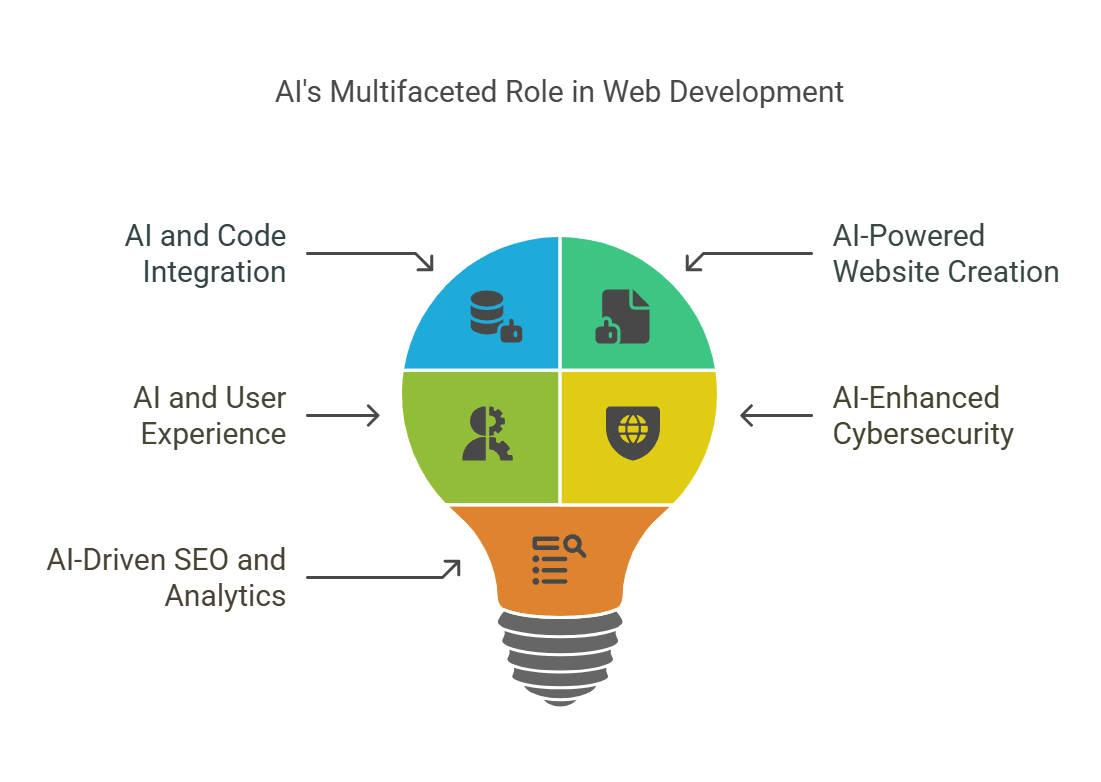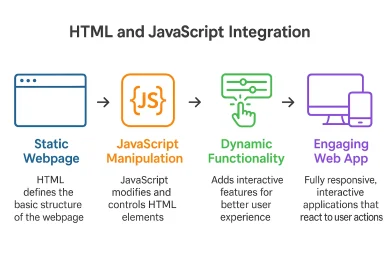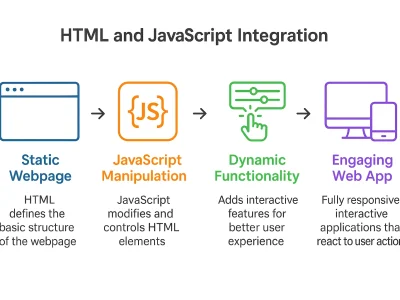Introduction
Artificial intelligence (AI) is revolutionising web development by appreciating automation, personalisation and decision-making processes. From coding tasks to enhancing user experience, AI is making web development smarter and more efficient.
AI-driven tools are also innovating user experience through dynamic personalisation.
These AI tools help to improve conversion rates with user satisfaction. Hence, these tools are utilized by both large-scale and small-scale businesses to improve their digital availability.
In this modern era, AI tools for web development allow the developer to focus on creativity and performance within a limited time. This helps the business to achieve user satisfaction with optimal performance for automating repetitive tasks.
A survey by the U.S. Chamber of Commerce and Teneo proves that nearly 40% of small businesses utilise AI tools with generative AI for tasks like content creation. As the future of AI in web design evolves, the integration in the web development process is assured to drive innovation and efficiency across the world.

The Evolution of AI in Web Development
AI in web development has profoundly progressed from simple automation to complex decision-making processes which can generate code, analyse data and improve user performance. Earlier to the progress of AI, web development was achieved by a high level of programming expertise. The rapid advancement in AI technology provides access to powerful tools that simplify the process, improve performance and reduce human effort.
Early Stages of AI Automation in Web Development
Initially, Web development uses AI for automating repetitive tasks which reduces human effort and improves performance rate. Developers use simple scripts or algorithms and code packages of AI to perform code formatting, checking syntax errors, autocorrecting grammars and maintaining databases. The invention of early automation features in AI tools like Dreamweaver, WordPress and Wix introduces drag-and-drop functionality for creating websites. This helps the developer to create a website more quickly with minimal effort.
Rise of AI-powered Website Builders
With the advancement of AI-powered website builders like Wix ADI (Artificial Design Intelligence, CodeWP and 10 Web AI builders, website creation becomes easier and more intuitive. User or developers needs to answer a few questions about their business and website needs. With the help of these answers, AI analyses the given data and creates layouts, colour schemes and content structures. Then, AI website builder tools create an entire website with the required design preferences. This significantly reduces the design effort of humans.
Key breakthroughs in AI Integration for Web Development
The advent of AI-powered code generation tools was one of the most transformative elements of AI evolution in web development. By helping developers to write code, offering suggestions for code enhancement, and finding errors in real-time, platforms like Github Copilot and openAI Codex, innovated the easier way for the coding process. These AI-integrated tools help the developer write complex programs effectively by minimising errors and speeding up the development cycles. Some of the main advancements of AI in web development are as follows
- AI-powered Website Builders
Traditional method of website creation involves manual coding, designing and optimizing which could take weeks or even months to finish. AI-powered website builders like Hostinger, Wix, and Jimdo, create a user preference website within a minute. Advancement in the automation of code generation is a significant change in the adoption of AI by developers.
- Natural Language Processing (NLP) and Chatbots
AI Integrated Chatbots are essential for customer service. Previously, Websites relied on human representatives for customer interaction which led to delayed responses. Advancements in NLP and chatbots like ChatGpt and Google Bards, naturally react to user interaction with immediate support. Thus it benefits website development by minimal operational cost, and speedy interaction to resolve the issues as earliest as possible.
- Cybersecurity Enhancements
Advancement in AI tools for web development increases the threat to the security level also. AI-powered cybersecurity tools detect and prevent cyber attacks at much earlier stages by analysing patterns and abnormalities in real time. This proactive approach to the potential threats has strengthened the website’s security against malware and hackers.
- AI-Driven SEO and Content Optimization
AI-driven SEO tools are used to identify trends, user intent and keywords for a website. AI also automates the creation of meta description and Title tag optimization. It analyses the website pages and suggests the best content structures for better readability. Engagement metrics, bounce rates and conversion rates are monitored effectively by AI tools without much human effort.
Current AI Trends in Web Development
Several trends have emerged to showcase the profound impact of AI in the web development industry. AI has new algorithmic approaches for both frontend and backend web development processes. AI trends also enhance testing, debugging and security measures to obtain faster and smarter results.
AI-Driven Front-end Development
Enhancing UI/UX
AI in UI/UX design brings a new approach to implementing design automation and layout generation. User behaviour and preferences are analysed by AI-driven tools to generate a user-personalised interface. This improves user engagement and satisfaction. For example, AI algorithms change the layout of websites in real-time applications based on user interaction to achieve seamless integration.
To learn how to implement AI-driven UI/UX strategies effectively, check out Tutedude’s UI/UX Design and Web Development Course.
Automating Content Creation
AI-driven automation helps to analyse other website pages and suggests users create optimal content structures. These AI-driven tools generate textual content, and virtual assets to suggest design layouts. This automation allows the developer for the faster deployment of web pages by reducing the workloads of developers and designers.
AI in Backend Development
AI-powered back-end Development provides advancement in code generation, optimising servers, enhancing performance and database management techniques.
Code Generation
The main constructive advancement of AI-driven tools in web design is the automation in code generation. Advanced AI models can write code snippets or entire code generation for an application based on high-level instructions and accelerated development cycles. This method not only increases the code generation but also achieves fewer human errors.
Optimizing Servers and Enhancing Performance
Server optimisation is achieved by analyzing network traffic and user behaviour continuously in real-time applications. This improves the speed of webpage load time and reduces downtime. This monitors server performance and predicts potential issues before escalation. This approach enhances the reliability of web pages.
AI for testing, debugging and security
Automated Bug Fixing
Machine learning algorithms in AI enhancement identify anomaly codes and powerful bugs to suggest fixes to resolve them. Thus it reduces the timing of manual testing and ensures robust and error-free applications. AI plays a significant role in the advanced transformation of the testing and debugging phase of web development.
Cybersecurity Enhancements
AI-driven tools are used to analyse network traffic and user behaviour continuously. With these results, it identifies suspicious activities which cause cyber threats to the web application. Sensitive data and user data are protected by prompt responses in real-time monitoring. This protects web applications from possible security breaches. Some AI tools like Darktrace use machine learning algorithms to analyse network behaviour.
AI tools Transforming web development
There are so many AI tools that are introduced to enhance efficiency, accuracy and user engagement in the web development cycle. These tools range from coding to testing and content management.
Essential AI-powered tools for Developers
Coding streamline, improved code quality and productivity boosts are achieved by various AI-driven tools. These tools assist in learning a new programming language, code completion and debugging. Developers use these AI tools to achieve development tasks in reduced time and effort.
Github Copilot
GitHub and openAI, copilot tools support multiple programming languages. This tool develops an AI-powered coding assistant which provides autocomplete code snippets and real-time code suggestions. Based on the context of the code being written, Github offers code function recommendation which simplifies the development task.
Tabnine
Tabnine is an essential AI-powered tool utilised by highly experienced developers. It anticipates deep learning algorithms to predict and suggest the next line of code snippets. It also integrates with various code editors to support multiple programming languages. It accelerates developer productivity by speeding up the coding process.
AI Code generators: Speeding up Development and Reducing errors
AI Code Generators develop the entire code function from natural language description. These advancements help to achieve improved development cycles with minimal human errors.
Qodo
Qodo is an AI-powered code generation tool to assist developers in writing and understanding code. It supports multiple programming languages. Qodo Formerly known as codium, streamline the code review process and strengthen test coverage.
Cursor
Cursor is an AI-driven code editor that supports developers to write codes more efficiently. This editor influences large language models to offer fully explained, complete and transformed code. Thus it is widely used by developers to speed up the code generation with reduced human errors.
AI Testing Tools (Automated Testing for Reliable Websites)
The reliability and functionality of the website are achieved by the AI testing tools. AI in Software Testing tools are essential to achieve automation and accuracy in the testing process.
Testim
Testim AI-driven testing tools generate, execute and maintain test cases for web and mobile applications. This tool accelerates the automation of creating and maintaining test cases.
Applitools
Applitools is one of the non-coding approaches for testing coverage and efficiency. It uses the latest generative AI technology combined with Visual AI to perform a highly efficient end-to-end testing and Compatible testing process in the web development cycle.
AI-powered Content Management System
Content Management System (CMS) is one of the critical aspects of the Web development cycle. AI-powered tools help to achieve CMS with efficient and intelligent updation of websites according to the current trend. This makes the website updates easier and smarter.
Hubspot’s CMS
Hubspot’s CMS is a free package of Content Management Solutions to support SEO optimisation, adaptive testing and personalised content recommendations. Most of the developers and marketers efficiently use Hubspot’s CMS to achieve effective generation and monitoring of website content.
Hostinger AI Website Builder
Hostinger offers AI-driven website design suggestions. It allows the developers to choose the design templates based on their needs and suggest content creation for the websites (Salminen, M., 2025). It has an SEO optimization tool which is more beneficial for small business owners and individuals who wish to have an online presence without much technical expertise.
Case Studies: AI in action
Several real-time applications have a profound impact on the web development industry.
Airbnb
Over 4 million photos are listed on Airbnb to improve search relevance. Deep learning neural networks are implemented to classify objects and scenes within images. AI tools automatically tag and categorise photos based on the classification to make listings more discoverable for improved guest experience. This AI-driven approach helps to avoid inefficient manual tagging of photos which leads to faster bookings.
Asos
Online Fashion Retailer Asos introduces virtual try-on apparel with AI technology to solve customer requirements about fit and sizing. This technology is achieved by computer vision AI to overlay products on customer photos. It helps to visualise apparel on their body shape before purchasing. Thus it replicates the in-store changing room leading to a higher conversion rate.
GoDaddy
GoDaddy is utilised by small and micro businesses to register their domains. This largest domain registrar provides AI-powered service, GoDaddy Airo, website creation and optimization. Thus businesses without technical expertise can also make an online presence with the help of these AI website creation tools.
Challenges and Ethical Consideration
Though AI offers various benefits, the integration of AI into different sectors faces challenges and ethical considerations that need careful observation.
Impact of AI in Developer Jobs: The rise of AI tools to automate code generation, customer interaction, and handling repetitive tasks results in the replacement of developers entirely. According to Forbes, AI coding makes the developers focus on complex and creative-level problem-solving techniques rather than focusing on repetitive tasks.
Security risk and Data protection: The integration of AI in web development sometimes leads to privacy violations. This increases the concerns about security and data protection. The organisation needs to implement robust data protection strategies to diminish these risks.
Addressing Bias and Ethical Consideration in AI Systems: AI tools are responsible for biases present in any training data. This may result in unfair treatment of certain groups as it predicts the data based on biased data. The organisation needs to implement measures that promote fairness and prevent discrimination.
Future Insights: What’s Next for AI in Web Development?
Predictions for AI’s Role in Web Design and Development
Automated Code Generation
AI-driven tools are increasingly used for achieving Code Generation for web applications without any technical expertise. According to Dario Amodei, CEO of Anthropic, AI may write up to 90% of code for the entire web application in the future. This results in the developer focusing on highly complex and more creative strategic tasks.
Customized User Experiences
Deep learning neural Networks and Natural Language processing allow AI tools to analyze user behaviour and preferences. Real-time analysis facilitates the creation of adaptive and personalized designs. This leads to more intuitive and engaging websites based on individual preferences.
Enhanced Decision Making
The analysis based on AI-powered tools contributes to developers with a deeper understanding of user interaction and preferences. AI suggests developers about design choices and content strategies to meet high conversion rate audiences.
The Rise of AI-Powered Web Assistants and Automation
Custom AI Agents
With the help of OpenAI, businesses may develop customised AI agents for jobs like financial analysis, customer support and repetitive tasks. This enhanced user satisfaction technology increases the efficiency of web functionalities.
Advanced Virtual assistant
Repetitive tasks are automated by AI-driven virtual assistants to reduce operational costs. This approach provides timely and accurate responses to inquiries for better user experience.
Browser Automation
AI-powered browser Automation transforms the business interaction with the web application leading to faster and more secure web services.
Conclusion
The ongoing evolution of Artificial Intelligence in Web development transforms the way of code generation, debugging and automating tasks to attain improved efficiency and user experiences. In order to remain competitive in this revolutionised AI world, Developers and Marketers can stay awake by learning AI tools and upskilling with recent trends to focus on more complex and creative problem-solving techniques. This leads to the industry-changing adaptation and maintaining relevance in an AI-driven world.





